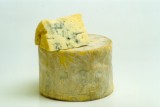|
Cheese
Focus Cheese
Focus Cheese Focus
 |
Cashel
Blue
Co. Tipperary,
Ireland
|
Jane and Louis
Grubb started making Cashel Blue in the 1980's and since then it
has earned an enviable international reputation as Ireland's most
famous blue cheese. It takes its name from the Rock of Cashel, a
bold outcrop overlooking the Tipperary plains.
Cashel Blue is
made from the milk of Jane and Louis' own herd of 110 Fresian cows.
It is made in a similar way to Roquefort although it is softer,
more moist and less salty. The milk is pasteurised, cooled and then
inoculated with Penicillin roquefortii and left at 32°C to allow
the acidity to rise. Rennet is then added and it is left to set
for an hour. The curd is then cut and left for another hour before
being removed from the vat in scrim cloth (raw Irish linen), drained
and tipped straight into the moulds. For the next two or three days
it is left to drain and turned from time to time until dry enough
for salting and piercing. The cheese is placed on a turn table and
rotated whilst being pierced with long stainless steel needles.
This allows air to enter the cheese and leads to the development
of the blue mould. Before wrapping in distinctive gold foil, the
cheeses are washed to remove the blue mould from the outside.
When young the
cheese is firm and relatively moist with a fresh and slightly sharp
flavour. With ageing it evolves a melt-in-the-mouth creaminess and
a rounder, mellower flavour. Cashel Blue can be matured for up to
six months. All the milk used for the cheese is now pasteurised.
The very best cheese is made from April to October when the cows
are out to pasture, but Cashel Blue is still excellent throughout
the year.
Each cheese is
12cm in diameter, 12cm in height, weighs 1.5kg and has a fat content
of 54%. Cashel Blue is excellent on the cheese-board and is a favourite
for cooking since it melts smoothly and retains its depth of flavour.
back to top
|
Breeds of milking cow.
Over many thousands
of years cross-breeding has produced many different types of cow.
The animals are generally bred for either milk or beef, rarely both.
The migration of man has led to the spread of these breeds through
out the world, although a few countries have retained their traditonal
breeds. For example, the rare Red Poll of Wales is used to make
Llanboidy cheese and the rare Gloucester is used to make limited
amounts of Stinking Bishop.
Ayrshire - Originally bred in Scotland this hardy
cow now represents 10% of the English herd. Excellent milk exceeded
in richness only by Jerseys and Guernseys.
Dairy Shorthorn - This breed represents only 2-3%
of the British herd.
Jersey - Once called the 'Alderney', the Jersey
produces almost as much milk as the larger Guernsey, with a high
butterfat content.
Fresian - The Fresian represents 80% of Britain's
milk production and is found all over Western Europe and the USA.
It has one of the highest milk yields of all
cows.
Normandy - Thought to have been bred by the Vikings
who, after invading France, crossed their own animals with the local
breeds. France's most popular cow.
Guernsey - This cow can produce 3500 litres of golden-yellow
milk per year. Breton monks living on Guernsey during the Middle
Ages are thought to have bred this gentle cow.
Braunvieh - The most popular breed in Switzerland
is also known as the Swiss Brown. It has also become popular in
America.
back to top
|
|
TIME
FOR 'BEAVER'
In the 18th century workers
had very long hard days but were allowed to stop for breakfast,
elevenses, dinner and fourses. Elevenses, often consisting
of bread and cheese, was also called 'beaver'. Eton college
used to have 'Beaver Days', when extra bread, cheese and beer
was issued for the boys to entertain visitors in Hall.
At The Teddington Cheese
we have put together a 'beaver' which will help you get through
the working day. It includes:
- 6oz Applebys Red Cheshire
- to be eaten like a piece of cake
- a jar of cows' milk Boilíe
- a packet of Cottage Delight Oatcakes on which to spread
the Boilíe
- a bottle of Crones Organic apple juice with which to wash
it all down (contains no alcohol so you can continue to work
afterwards)
Your 'beaver' bag
only
£8.50
Please allow 24
hours for delivery (normal delivery rules apply).
SORRY OFFER
NOW OVER
|
Cabbage
salad with blue cheese
serves 6-8
ingredients:
1/2
hard white or red cabbage
4 parsley sprigs
225g crisp apples
100g small carrots
1/2 tsp. fresh thyme
salt and black pepper to taste
pinch of curry powder
225g Cashel Blue
65ml yogurt
65ml mayonnaise
1. Shred
the cabbage very finely and soak in cold water for 2 hours, changing
the water every 30 minutes. Then drain and dry well.
2. Finely chop the parsley.
3. Peel and core the apples, top and tail the carrots and coarsely
grate both.
4. Combine the apples, carrots and parsley with the cabbage and then
add the thyme, seasoning and curry powder and mix well.
5. Cut the Cashel Blue into small cubes and fold them into the salad.
6. Mix together the yogurt and mayonnaise and then pour over the salad.
7. Toss salad shortly before serving.
back to top
|
|